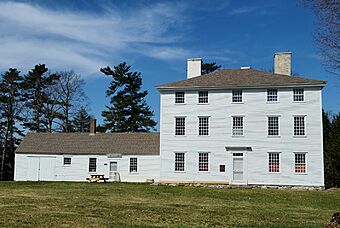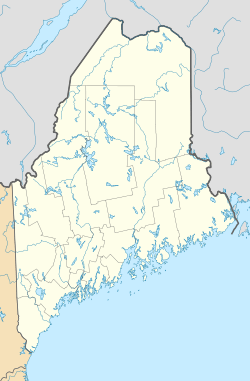Pownalborough Courthouse facts for kids
Quick facts for kids |
|
|
Pownalborough Courthouse
|
|

The Courthouse in April 2023
|
|
| Location | 23 Courthouse Road, Dresden, Maine |
|---|---|
| Area | 56 acres (23 ha) |
| Built | 1761 |
| Architect | Flagg, Gersham |
| NRHP reference No. | 70000052 |
| Added to NRHP | January 12, 1970 |
The Pownalborough Courthouse is a very old building in Dresden, Maine, USA. It was built in the early 1760s. This courthouse was the first one for Lincoln County, which started in 1760. It is the only courthouse left in Maine that was built when America was still a group of colonies. Today, it is a museum run by the Lincoln County Historical Society. The courthouse was added to the National Register of Historic Places in 1970 because of its important history.
Contents
About the Pownalborough Courthouse
The Pownalborough Courthouse is in a quiet, rural part of Dresden. It looks out over the Kennebec River to the west. When it was built, this area was home to Fort Shirley. This fort was one of the first British forts built inland along the river.
The courthouse is a large, three-story building made of wood. It has a sloped roof and wooden siding. The front of the building has five sections, with the main door in the middle. This door has decorative columns and a fancy top. A smaller, one-story section extends from one side. Inside, some parts have been changed over time, but the wide original floorboards are still there. The building has never had electricity or modern plumbing.
How Lincoln County Started
Lincoln County was created in 1760. Before that, it was part of York County, Massachusetts. At that time, Maine was still part of Massachusetts. The county was named after Governor Thomas Pownall. The town of Pownalborough was also named after him. This town included what are now Dresden, Alna, Jefferson, and Wiscasset.
Building the Courthouse
The people who owned the land, called the Kennebec Proprietors, decided to build a courthouse in 1760. They chose to build it on the land where Fort Shirley stood. Fort Shirley was built in 1752 to protect against attacks. But by 1760, it was not as important because Fort Western had been built further up the river. The owners thought the fort's buildings could be used for a jail and a place for a keeper to live.
Construction of the courthouse began in 1761. The county's first court meeting happened in the building later that year, even though it was not finished. The courthouse was finally completed in 1769.
Many Uses of the Building
Besides being a court, the building was used for many other things. It was a tavern, an inn, and even a post office. People also used it for fencing lessons, dances, church services, and town meetings. The third floor had living spaces. Major Samuel Goodwin, who was the fort commander, lived there. His family continued to live in the building until the 1930s. In 1954, the local historical society bought the 56-acre property from Goodwin's family.
Famous Visitors and Cases
Many important people visited the Pownalborough Courthouse. Some famous legal cases also took place there.
John Adams's Early Career
One famous person who visited was John Adams. He was a young lawyer fresh out of school and later became the second President of the United States. Adams argued a property case at the courthouse. He wrote in his journals that he did not like the trip to Pownalborough. The roads were muddy and rough, and he often complained about trees blocking his path. Most people traveled to the court by the Kennebec River, which was easier and safer. John Adams was offered a job by the Kennebec Proprietors to help them with property cases. He agreed, but only if he could work out of the Falmouth (now Portland, ME) Courthouse instead. This job helped start his successful career as a lawyer.
Benedict Arnold's Expedition
Benedict Arnold also visited the courthouse during his famous trip to Canada. When Arnold arrived, Major Samuel Goodwin, the court's caretaker, refused to give him maps of the area that he had made himself. At that time, Major Goodwin supported the British, while Arnold was fighting for American independence. After an argument with his own son, who supported the American cause, Major Goodwin traveled to Fort Western. There, he finally gave the maps to Arnold and his group. After the war, Major Goodwin wrote to George Washington asking to be paid for the maps.
A Notable Court Case: Rebecca Foster
One of the most talked-about cases at the Pownalborough Courthouse involved a serious accusation against Judge North in 1787. This case is important because it was the first time a woman gave expert medical testimony in court.
Martha Ballard was a midwife from Hallowell. She was known for her skill, bravery, and strong religious beliefs. She would do anything for her patients, even crossing the Kennebec River in the middle of winter to deliver babies when no one else would. She was friends with Reverend Issac Foster and his wife, Mrs. Rebecca Foster.
Judge North did not like Reverend Foster's way of preaching. He worked to get the Reverend fired, and he succeeded. Reverend Foster left town to find a new job, leaving his wife at home. Mrs. Foster told Martha Ballard that three men had broken into her house and harmed her, including Judge North.
Martha Ballard urged Mrs. Foster not to bring the case to court, but Mrs. Foster insisted. When charges were filed, Judge North tried to avoid being arrested. He said it was embarrassing to be arrested by his own men. He was the first to go to trial. The other two accused men claimed they were out of town. A key piece of evidence was that Mrs. Foster was pregnant, and her husband had been away. Judge North said that Mrs. Foster was not a liar and was a good person. He claimed she simply made a mistake in identifying him.
When Martha Ballard was called to testify, she wrote in her diary that she was sure Judge North was responsible, and so were her friends. When Judge North was found not guilty, it deeply upset Martha Ballard, who was very religious. She refused to attend public church services for seven years after that. It is worth noting that the charges against Judge North were changed from a very serious crime to a less severe one. Also, at that time, cases where women made accusations were sometimes seen as ways for men to fight each other. People might have thought that the Reverend told his wife to press charges to get back at Judge North for getting him fired.
The Courthouse Today
Today, the Pownalborough Courthouse is a museum. It is open during certain times of the year, usually from Memorial Day to Columbus Day. There is a fee to enter.
The land around the courthouse also has a system of trails. Some of these trails and the public bathrooms are designed to be accessible for everyone.
See also



